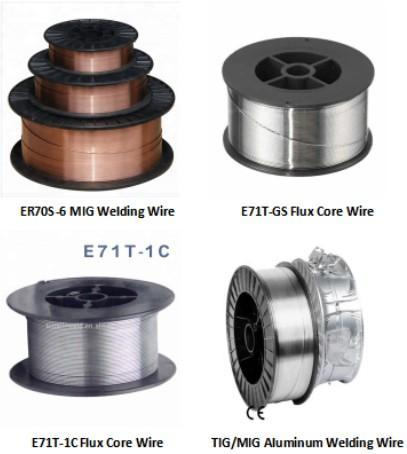Selection of solid core welding wire

Submerged arc welding wire
During submerged arc welding, the flux protects and metallurgically treats the weld metal. The welding wire is mainly used as a filler metal, while adding alloying elements to the weld and participating in the metallurgical reaction.
- Welding wire for low carbon steel and low alloy steel
There are three types of commonly used welding wires for submerged arc welding of low carbon steel and low alloy steel.
(1) Low manganese welding wire (such as H08A): often used with high manganese flux for welding of low carbon steel and low alloy steel with lower strength.
(2) Medium manganese welding wire (such as H08MnA, H10MnS): mainly used for welding low alloy steel, and can also be used with low manganese flux for welding low carbon steel.
(3) High manganese welding wire (such as H10Mn2 H08Mn2Si): used for welding low alloy steel.
- Wire for high-strength steel
This type of welding wire contains more than 1% Mn and 0.3%~0.8% Mo, such as H08MnMoA and H08Mn2MoA, and is used for welding low-alloy high-strength steel with higher strength. In addition, according to the composition and performance requirements of high-strength steel, elements such as NI, CR, V and Re can also be added to the welding wire to improve the performance of the weld. Weld metal with a tensile strength of 590Mpa mostly uses MN-MO series welding wire, such as H08MNMOA, etc.
- Welding wire for stainless steel
The composition of the welding wire used should be basically the same as that of the stainless steel being welded. When welding chromium stainless steel, use welding wires such as HoCr14 H1Cr13 H1Cr17; when welding chromium-nickel stainless steel, use welding wires such as H0Cr19Ni9 HoCr19Ni9 HoCr19Ni9Ti; when welding ultra-low carbon stainless steel, use corresponding welding wires. For ultra-low carbon welding wires, such as HOOCr19Ni9, etc., the flux can be smelted or sintered, and the flux is required to have low oxidation to reduce the burning loss of alloy elements. At present, sintered flux is mainly used to weld stainless steel abroad. In my country, smelting flux is still the main method, but the use of sintered flux is being developed and promoted.
Welding wire for gas shielded welding
Gas shielded welding is divided into inert gas shielded welding (TIG welding and MIG welding), active gas shielded welding (MAG welding) and self-shielded welding. Pure Ar is used during TIG welding, and Ar+2%O2 or Ar+5%CO2 is generally used during MIG welding. CO2 gas is mainly used during MAG welding. In order to improve the process performance of CO2 welding, CO2+Ar or CO2+Ar+O2 mixed gas or flux-cored wire can also be used.
- TIG welding wire
TIG welding sometimes does not add a filler wire. The base metal to be welded is heated and melted and then connected directly. Sometimes a filler wire is added. Since the shielding gas is pure Ar and has no oxidizing properties, the composition of the welding wire basically does not change after melting, so the composition of the welding wire is the welding wire. Sewing ingredients. Some also use the base metal composition as the welding wire composition to make the weld composition consistent with the base metal. During TIG welding, the welding energy is small, the weld strength, plasticity and toughness are good, and it is easy to meet the performance requirements.
- MIG and MAG welding wire
The MIG method is mainly used for welding high alloy steels such as stainless steel. In order to improve the arc characteristics, adding an appropriate amount of O2 or CO2 gas to the Ar gas becomes the MAG method. When welding alloy steel, using Ar+5%CO2 can improve the anti-porosity ability of the weld. However, Ar+5%CO2 mixed gas cannot be used when welding ultra-low carbon stainless steel. Only Ar+2%O2 mixed gas can be used to prevent carbonization of the weld. At present, MIG welding of low alloy steel is gradually being replaced by MAG welding of Ar+20%CO2. Since the shielding gas has certain oxidizing properties during MAG welding, the content of deoxidizing elements such as Si and Mn in the welding wire should be appropriately increased. The other components can be the same as the base material, or they can be different. When welding high-strength steel, the C content in the weld is usually lower than the base metal, and the Mn content should be higher than the base metal. This is not only for deoxidation, but also a requirement for the welding alloy composition. In order to improve low temperature toughness, the Si content in the weld should not be too high.

